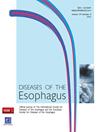438. TECHNIQUE OF COMPLETELY ROBOTIC MCKEOWN (3-HOLE) ESOPHAGECTOMY WITH INTRA-CORPOREAL GASTRIC CONDUIT CREATION, AND CERVICAL ESOPHAGO-GASTRIC ANASTOMOSIS FOR MID-ESOPHAGEAL ADENOCARCINOMA
IF 2.3
3区 医学
Q3 GASTROENTEROLOGY & HEPATOLOGY
引用次数: 0
Abstract
Background Esophageal cancer is the 7th leading cause of cancer deaths, with an estimated total case of 22,370 in both males and females in 2024. Adenocarcinoma and squamous cell carcinoma account for over 90% of histology at diagnosis. The incidence of adenocarcinoma continues to rise due to the rising incidence and prevalence of obesity, gastro-esophageal reflux disease and Barrett's esophagus. Multi-modality treatment is currently the standard of care for locally advanced disease. This consists of neoadjuvant concurrent chemotherapy and radiation therapy, followed by esophagectomy. Minimally invasive approaches to esophagectomy are associated with decreased post-operative morbidities and overall satisfactory outcomes. While the Ivor Lewis esophagectomy with intra-thoracic anastomosis is the most common surgical approach to resection of distal esophageal and gastroesophageal (GE) junction tumors, the McKeown (3-hole) esophagectomy with cervical esophago-gastric anastomosis is best suited for tumors located in the proximal and mid-esophagus. Methods We describe our technique of robotic McKeown (3-hole) esophagectomy for mid-esophageal adenocarcinoma after neoadjuvant concurrent chemo-radiation therapy for clinical stage uT3N0M0 tumor. The thoracic esophagus is completely mobilized from the esophageal hiatus of the diaphragm up to the thoracic inlet via a right thoracoscopic approach, with harvesting of the regional lymph nodes together with the specimen. The left neck incision is made along the anterior border of the sternocleidomastoid muscle and the inferior belly of the omohyoid muscle is transected. The cervical esophagus is then completely mobilized into the wound and secured using a Penrose drain. Using a laparoscopic approach, the entire stomach is mobilized with division of the left gastric vessels but careful preservation of the right gastro-epiploic arcade while transecting the greater omentum and the short gastric vessels. An intra-corporeal creation of the gastric conduit then follows. The gastric conduit, secured to the proximal stomach at the resection staple line, is subsequently tunneled via the esophageal hiatus and through the mediastinum to exit at the left neck incision by applying traction on the cervical esophagus. The specimen is separated from the conduit, and the cervical esophagus is transected at the desired location for the anastomosis. A stapled end-to-side but functional end-to-end esophago-gastric anastomosis (Orringer's technique) is then created. Results A completely robotic technique of McKeown (3-hole) esophagectomy without the need to exteriorize the stomach to fashion the gastric conduit via a (mini)laparotomy is successfully accomplished in the majority of our patients with proximal or mid-esophageal tumors. An uneventful postoperative recovery was made. Fluoroscopic esophagram on post-operative day 5 did not demonstrate leakage from the anastomotic site. Gastric conduit emptying was satisfactory despite the lack of a routine gastric drainage procedure or injection of botulinum toxin into the pyloric ring. Conclusion Robotic-assisted thoracoscopic esophageal mobilization combined with laparoscopic completely intra-corporeal fashioning of gastric conduit with cervical esophago-gastric anastomosis is a technically feasible minimally invasive approach to performing McKeown esophagectomy with satisfactory post-operative outcomes and conduit functioning. https://www.dropbox.com/scl/fi/gzc1vzdzhzqn7niz95b8t/Robotic-McKeown-Esophagectomy-Video-3.mp4?rlkey=c4ja7s1aob10ah6ps500z7y29&dl=0438.全机器人麦克康(3 孔)食管切除术,体外胃导管创建和颈部食管-胃吻合术治疗食管中段腺癌的技术
背景 食管癌是导致癌症死亡的第七大原因,预计 2024 年男性和女性的总病例数均为 22,370 例。腺癌和鳞癌占诊断组织学的 90% 以上。由于肥胖症、胃食管反流病和巴雷特食管的发病率和流行率不断上升,腺癌的发病率持续上升。多模式治疗是目前治疗局部晚期疾病的标准方法。这包括新辅助同步化疗和放疗,然后进行食管切除术。微创食管切除术可降低术后发病率,总体疗效令人满意。带胸腔内吻合的 Ivor Lewis 食管切除术是切除食管远端和胃食管(GE)交界处肿瘤最常用的手术方法,而带颈部食管-胃吻合的 McKeown(3 孔)食管切除术最适合切除位于食管近端和中段的肿瘤。方法 我们介绍了针对临床分期为 uT3N0M0 的中段食管腺癌,在新辅助化疗和放疗同时进行后,采用机器人麦氏(3 孔)食管切除术的技术。通过右胸腔镜方法,从横膈膜食管裂孔直至胸腔入口处完全移除胸腔食管,并将区域淋巴结和标本一并摘除。沿着胸锁乳突肌前缘做颈部左切口,横切蝶骨肌下腹部。然后将颈部食管完全移入伤口,并用彭罗斯引流管固定。使用腹腔镜方法移动整个胃,分割左侧胃血管,但小心保留右侧胃外膜弧,同时横切大网膜和短胃血管。然后在体腔内建立胃导管。将胃导管固定在切除缝合线处的近端胃上,然后通过食管裂孔和纵隔,在颈部食管上施加牵引力,从左颈部切口穿出。标本与导管分离,在吻合所需的位置横切颈食管。然后用订书机进行端对端但功能性的端对端食管-胃吻合术(Orringer 技术)。结果 我们的大多数食管近端或中段肿瘤患者都成功完成了完全机器人技术的麦氏(三孔)食管切除术,而无需通过(迷你)开腹手术将胃移出以形成胃导管。术后恢复顺利。术后第 5 天,透视食管造影显示吻合口部位没有渗漏。尽管没有进行常规胃引流手术,也没有在幽门环注射肉毒杆菌毒素,但胃导管排空情况令人满意。结论 机器人辅助胸腔镜食管移动术结合腹腔镜完全体腔内胃导管成型术与颈部食管-胃吻合术是一种技术上可行的微创方法,可用于实施麦氏食管切除术,术后效果和导管功能令人满意。https://www.dropbox.com/scl/fi/gzc1vzdzhzqn7niz95b8t/Robotic-McKeown-Esophagectomy-Video-3.mp4?rlkey=c4ja7s1aob10ah6ps500z7y29&dl=0
本文章由计算机程序翻译,如有差异,请以英文原文为准。
求助全文
约1分钟内获得全文
求助全文
来源期刊

Diseases of the Esophagus
医学-胃肠肝病学
CiteScore
5.30
自引率
7.70%
发文量
568
审稿时长
6 months
期刊介绍:
Diseases of the Esophagus covers all aspects of the esophagus - etiology, investigation and diagnosis, and both medical and surgical treatment.
 求助内容:
求助内容: 应助结果提醒方式:
应助结果提醒方式:


